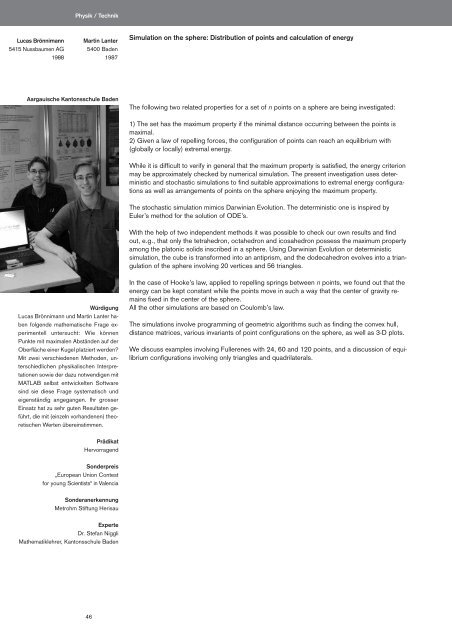SJf_Wettbewerbs_Broschüre_2007 - Die Goldene Sonne am Calanda
SJf_Wettbewerbs_Broschüre_2007 - Die Goldene Sonne am Calanda
SJf_Wettbewerbs_Broschüre_2007 - Die Goldene Sonne am Calanda
Sie wollen auch ein ePaper? Erhöhen Sie die Reichweite Ihrer Titel.
YUMPU macht aus Druck-PDFs automatisch weboptimierte ePaper, die Google liebt.
Lucas Brönnimann<br />
5415 Nussbaumen AG<br />
1988<br />
Physik / Technik<br />
Martin Lanter<br />
5400 Baden<br />
1987<br />
Aargauische Kantonsschule Baden<br />
Würdigung<br />
Lucas Brönnimann und Martin Lanter haben<br />
folgende mathematische Frage experimentell<br />
untersucht: Wie können<br />
Punkte mit maximalen Abständen auf der<br />
Oberfläche einer Kugel platziert werden?<br />
Mit zwei verschiedenen Methoden, unterschiedlichen<br />
physikalischen Interpretationen<br />
sowie der dazu notwendigen mit<br />
MATLAB selbst entwickelten Software<br />
sind sie diese Frage systematisch und<br />
eigenständig angegangen. Ihr grosser<br />
Einsatz hat zu sehr guten Resultaten geführt,<br />
die mit (einzeln vorhandenen) theoretischen<br />
Werten übereinstimmen.<br />
Prädikat<br />
Hervorragend<br />
Sonderpreis<br />
„European Union Contest<br />
for young Scientists“ in Valencia<br />
Sonderanerkennung<br />
Metrohm Stiftung Herisau<br />
Experte<br />
Dr. Stefan Niggli<br />
Mathematiklehrer, Kantonsschule Baden<br />
46<br />
Simulation on the sphere: Distribution of points and calculation of energy<br />
The following two related properties for a set of n points on a sphere are being investigated:<br />
1) The set has the maximum property if the minimal distance occurring between the points is<br />
maximal.<br />
2) Given a law of repelling forces, the configuration of points can reach an equilibrium with<br />
(globally or locally) extremal energy.<br />
While it is difficult to verify in general that the maximum property is satisfied, the energy criterion<br />
may be approximately checked by numerical simulation. The present investigation uses deterministic<br />
and stochastic simulations to find suitable approximations to extremal energy configurations<br />
as well as arrangements of points on the sphere enjoying the maximum property.<br />
The stochastic simulation mimics Darwinian Evolution. The deterministic one is inspired by<br />
Euler’s method for the solution of ODE’s.<br />
With the help of two independent methods it was possible to check our own results and find<br />
out, e.g., that only the tetrahedron, octahedron and icosahedron possess the maximum property<br />
<strong>am</strong>ong the platonic solids inscribed in a sphere. Using Darwinian Evolution or deterministic<br />
simulation, the cube is transformed into an antiprism, and the dodecahedron evolves into a triangulation<br />
of the sphere involving 20 vertices and 56 triangles.<br />
In the case of Hooke’s law, applied to repelling springs between n points, we found out that the<br />
energy can be kept constant while the points move in such a way that the center of gravity remains<br />
fixed in the center of the sphere.<br />
All the other simulations are based on Coulomb’s law.<br />
The simulations involve progr<strong>am</strong>ming of geometric algorithms such as finding the convex hull,<br />
distance matrices, various invariants of point configurations on the sphere, as well as 3-D plots.<br />
We discuss ex<strong>am</strong>ples involving Fullerenes with 24, 60 and 120 points, and a discussion of equilibrium<br />
configurations involving only triangles and quadrilaterals.


